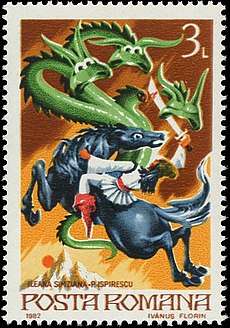Ileana Simziana
Ileana Simziana or Ileana Sînziana (also translated to English as The Princess Who Would be a Prince or Iliane of the Golden Tresses[1] and Helena Goldengarland[2]) is a Romanian fairy tale collected and written down by Petre Ispirescu between 1872 and 1886.[1] It tells the story of an unnamed youngest daughter of an emperor, who dresses up as a man, goes to serve another emperor and rescues the titular princess Ileana. During a quest of obtaining the Holy Water she is hit by a curse of a monk that causes her to transform into a man - Făt-Frumos (Prince Charming figure), who marries Ileana in the happy ending.

Synopsis
The tale introduces an emperor with three daughters, who is sad that he didn't have a son. The oldest daughter goes to the emperor and asks him what problem he is having and tells him that she will go to serve another emperor as a soldier only to make him happy. Then the emperor makes a copper bridge and turns into a wolf. The oldest daughter gets scared and goes back to the palace. The same happens with the middle daughter, who also gets scared of the wolf. The youngest daughter goes on a journey with her father's old horse, and defeats him on three bridges, first as a wold, then as a lion, then as a twelve-headed dragon. The girl arrives at the court of a "great and strong emperor" and he tells her to rescue Ileana Simziana, his daughter, who had been kidnapped by the giant. The girl rescues her, and the emperor asks her to retrieve his herd enchanted mares, the girl succeeds in this spree. Then Ileana Simziana asks the emperor's daughter to bring the Holy Water kept in a small church above the Jordan and guarded by nuns who neither slept in the day nor in the night. The girl succeeds but the monk who takes care of the church prays to God and asks him if the thief is a man to make him a woman and vice versa, so that the princess becomes a prince - Făt-Frumos. He marries Ileana Simziana and they live happily ever after.
Variants
A variant of this story, entitled The Girl Who Pretended to be a Boy, was published in 1901 in Andrew Lang’s The Violet Fairy Book, and was an English translation of a tale from the 1894 Romanian Sept Contes Roumains (Seven Romanian Stories), edited by Jules Brun and Leo Bachelin.[1][3]
An Armenia variant exists, with the name The Girl who Changed into a Boy: in the story, it's the king's daughter, who the "hero" was married to, that orders her father to set the crossdressing knight into the perilous quests to dispose of "him".[4]
References
- Ready, Psyche Z. (2016-08-08). “She was really the man she pretended to be”: Change of Sex in Folk Narratives (Thesis thesis).
- "The Miraculous Tomcat and Other Stories - American Folklore Society". www.afsnet.org. Retrieved 2019-08-20.
- "Jouvencelle-Jouvenceau". In: Brun, Jules & Bachelin, Leo. Sept Contes Roumains. Librairie de Firmin-Didot. 1894. pp. 286-339.
- Downing, Charles. Armenian Folk-tales and Fables. London: Oxford University Press. 1972. pp. 83-86. ISBN 0-19-274117-9
See also
| Wikisource has original text related to this article: |
| Romanian Wikisource has original text related to this article: |